Many people write to me asking how to keep spiders as pets. Usually I ask what sort of spider they are intending to keep, as certain spiders adapt to captivity a lot better than others. The spider that many enthusiasts keep is usually the tarantula and it can occasionally be handled (with care) as well, as their bite is not usually dangerous to us. However tarantulas are subject to stress and really prefer not to be handled and it is very easy to damage them when being handled.
Personally I prefer to see spiders left in their natural habitat and observe them as they go about their daily lives – it’s much better for the spider and less work for me!! I have kept redbacks successfully in my classroom but they needed to be in a sealed container and only fed by me as I didn’t want any of my students being bitten!!
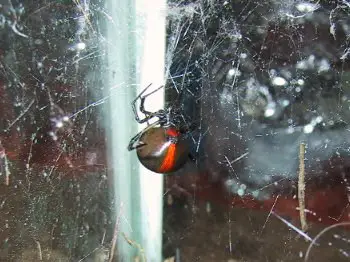
I don’t recommend keeping the larger web spinning garden orb weavers or argiopes as they can’t weave a big enough web in a small container and their life span is limited to around 6mths anyway. Hunting spiders are fine – wolf spiders and fishing spiders can live in an aquarium just fine but huntsman spiders need to roam and wouldn’t do well. You also need to be aware that a female spider can still lay an egg sac and have spiderlings without a male being present so you may end up with lots of babies running around your house.
Table of Contents
Finding the perfect pet spider
Look in a wide variety of habitats depending on what sort of spider you are trying to catch. You’ll find house spiders and widow spiders on window sills, cracks and corners inside and outside the house. You can look for lynx spiders, crab spiders and jumping spiders on trees and bushes.
Look in a wide variety of habitats depending on what sort of spider you are trying to catch. Funnel weavers live in the grass, and wolf spiders live in the dirt and leaf litter or under rocks. Tarantulas can be found in the desert and fishing spiders near streams and ponds.
I have kept redbacks successfully in my classroom but they needed to be in a sealed container and only fed by me as I didn’t want any of my students being bitten!! I don’t recommend keeping the larger web spinning garden orb weavers or argiopes as they can’t weave a big enough web in a small container and their life span is limited to around 6mths anyway. Hunting spiders are fine – wolf spiders and fishing spiders can live in an aquarium just fine but huntsman spiders need to roam and wouldn’t do well. You also need to be aware that a female spider can still lay an egg sac and have spiderlings without a male being present so you may end up with lots of babies running around your house.
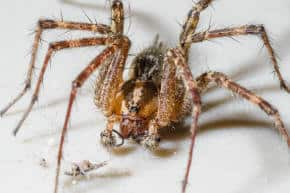
Catching the Spider
Use a jar and place it below the spider if its on a plant and it will drop into the jar. You can use mesh to sift through dirt and leaf litter. To catch a spider in a jar, approach it quietly (no, they will not jump onto you), and place a transparent jar gently over it, so that it ends up in the jar, being careful not to crush its legs. Then slide a piece of firm paper or card between the jar and the surface on which the spider is sitting. Keep the card against the mouth of the jar until you are ready to put it into its new home.
Keeping the Spider as a Pet
Food: Spiders are really easy to care for, although in Winter it is often hard to find food for them. Spiders eat insects of all sort, the smaller spiders and spiderlings will eat fruit flies and flies while the larger ones will eat cockroaches, grasshoppers and crickets up to small birds, frogs and even bats.
You can attract fruit flies by leaving out some leftover scraps of moist food. You can even grow your own normal flies by leaving out some food to attract flies to lay their eggs in and then put the maggots in the spider’s home. Crickets can be purchased at the pet shop. Spiders can go for long periods without food, find out how often your species needs to be fed and don’t over feed it. Dead insects lying on the bottom will mean the tank needs cleaning and it’s best not to disturb the spider too much.
Water
Some spiders need water and this can be provide in a lid with moistened cotton wool. You can also spray the tank but don’t over moisten as mould will grow and the spider will die.
The Container
Depending on the spider, you can keep it in anything from a jar to an aquarium. The size of the spider will dictate how big their container needs to be. The width of the tank should be two to three times wider than the leg span of the spider wide, and only as tall as the spider’s leg span. Some spiders need very little air so the top can be fairly well sealed to avoid little fingers getting in or small spiders getting out but for spiders like tarantulas air circulation is important. Try and provide a habitat as close to the spiders normal habitat – put in dirt and leaves, rocks and grass and somewhere to hide. 2-3 inches of peat moss, soil, or vermiculite can be used as a substrate. Wood, cork bark, or half of a small clay flower pot can be used for a shelter/retreat.
You don’t need to light the tank but can if you wish. Some spiders do have specific heating requirements though, so check this out depending on the spider you choose.
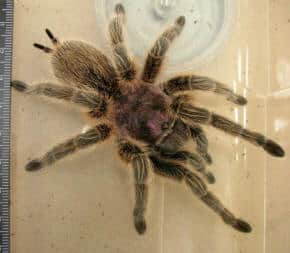
Care of Tarantulas
Housing
Some tarantula species are very “low-maintenance” pets, others require constant attention. As a general rule, ground-dwelling tarantulas from more arid climates are the easiest. Good examples include the Chilean rose, Grammostola rosea, and the desert blond Aphonopelma chalcodes. Arboreal species and those from wet regions often require more care and maintenance. Many plastic and glass containers can be adapted for tarantula homes.
Burrowing species, which are generally heavier, should not be kept in tall containers. They can rupture their abdomens or other body parts and quickly bleed to death if they climb up the sides and drop. They may also catch their feet in metal-screened tops and lose or break legs or be hurt in a fall.
Ground-dwelling species don’t need anything taller than their own length, stretched out. Container lengths should be at least about 2 1/2 times the legspan of the individual, by 1 1/2 times. Tarantulas that live in trees are called arboreal and don’t need the same things that the burrowing, ground-dwelling species do. Arboreal tarantulas tend to be longer in leg, thinner in body, and often the ends of their legs are broader than the rest of the leg. Cage height is not limited with arboreal tarantulas.
Air circulation in a container is almost never a bad thing, and arboreal tarantulas especially may die without it. Stagnant containers with very high humidity can easily breed moulds, fungi, bacteria and mites. If your particular tarantula doesn’t require high humidity, a water dish is fine without misting. Certain species do require higher humidity. Again, find out what species you’ve got. If you try to maintain your cobalt blue tarantula the same way as your Texas tan tarantula, you’ll quickly lose the cobalt blue. What do you need to put in the cage? Generally, substrate and shelter. Substrates can be vermiculite, peat moss, potting or topsoil. There is some reason to suspect that wood products, such as chips may improve the habitat for mites, setting the stage for problems, so they should probably be avoided. Never use cedar products, it is toxic to many arthropods. Different species of tarantulas are used to different conditions. Arboreal tarantulas live in trees and make their tube-web homes in holes in them, inside bark, or strung between parts of the tree. Solid wood, such as branches or boards are fine for them. Burrowers live in holes and may appreciate deep substrate and dug-in shelters.
Temperatures best for most tarantula species tend to be from 75-85° F. Up towards 90° F or over, you need to be very careful to watch the water dish and humidity. Tarantulas can be successfully kept colder in the winter, but need at least a good long warm season each year to thrive. Direct sunlight might be detrimental to some species, and bright lights may be disturbing to others.
Feeding
The most commonly used tarantula food is crickets and these can be bought at a pet store. These are fine, but a variety of diet is good too. If you catch insects for your spider, make sure they haven’t been exposed to pesticides, and avoid some earwigs and certain beetles (earwigs and some beetles can be dangerous or even poisonous). Larger tarantulas will often eat baby mice, and many tarantulas will take dead prey, or even pieces of meat — you can experiment. Drosophila (fruit flies) are good for small spiderlings, but a mixed diet is safest. Tarantulas will stop feeding when preparing to moult and food must be removed.
Handling And Bites
Tarantulas have small brains (but large for arthropods) and may react in unexpected ways to whatever they perceive as being a threatening situation for people not highly experienced with them. Tarantulas, especially the ground-dwellers, can easily be killed by even a short fall; they can be very fragile. The arboreal tarantulas are far less likely to be injured by a fall, but they tend to be very fast and can easily escape and be difficult to recapture.
Furthermore, tarantulas possess venom. There is no scientific evidence that any of their venoms are lethal, but bites from some species can be painful and cause unpleasant symptoms. Some people may be harmfully allergic to certain venoms. If you are bitten and have trouble breathing, see a doctor. Most tarantulas from North, South, and Central America have urticating (itch-causing) hairs on their abdomens. They can kick these in the air or in some cases press them into an “intruder.” This may cause bald spots on the abdomen, which is nothing to worry about. However, these hairs can cause rashes and occasionally bad eye inflammations in humans. Keep your face away from your spiders and wash your hands after any contact with their bodies or cage bedding. Benadryl may help with rashes.
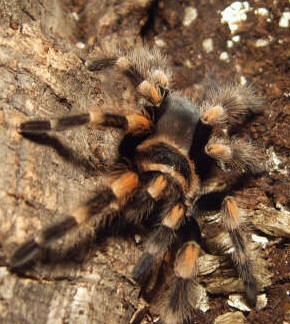
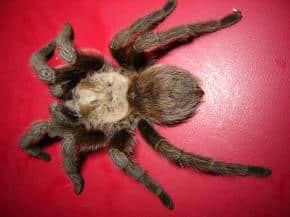
There are times when you need to move your spider from the cage (such as for cleaning).If you’re dealing with an especially skittish, fast animal, you can put it in the refrigerator for 10 or 15 minutes, and that will slow it down a lot. Don’t overdo it; the stress of the sudden temperature shock may be hazardous. Whenever you move a tarantula from one container to another, keep a plastic cup or fish net available to catch it with if it bolts. Gently brushing with a paintbrush will help get it going where you want it.
Moulting And Medical Problems
In order to grow larger, tarantulas must moult. They do this by splitting the exoskeleton (skin) on the carapace (top of the front body part where the legs are attached) and then working the rest of the body and finally the legs out of the moult. Usually they turn on their backs or sides to moult.
Before moulting, they will stop eating for a while. The time may be a few days for a small spiderling. Adults will stop feeding for few weeks to as long as several months before moulting.
Many insects such as crickets have the potential to attack and kill a moulting tarantula. Remove uneaten prey promptly. A spider that is upside-down with its legs in the air is almost certainly moulting. Don’t try to turn it over or touch it, or you may injure it. The exception to this is if it begins moulting while still right side up. With larger individuals, you may have to assist the moulting spider over onto its side to prevent leg damage or loss. After moulting, it will take an adult tarantula at least several days to harden its exoskeleton (new skin) and begin feeding. Don’t bother it until it recovers fully. It will probably be quite hungry, and eat heavily for awhile.
Adult tarantulas usually complete a moult within several hours. If your spider gets stuck in its moult, you may be keeping the humidity too low. Try misting it with water or a 1/20 dilution of glycerin.
If it goes over a day or so, drastic measures are needed. You can take a pair of forceps and very gently try to pull off the exoskeleton by pulling on the ends of the old leg skin.
If your tarantula becomes injured in any way and starts bleeding, it is likely to die if not treated. If it loses a leg during a moult, you may be keeping the humidity too low. Hemolymph (tarantula “blood”) is pale blue and the clotting systems to stop bleeding may not be sufficient if the wound is large enough. Wounds can be coated with triple nail hardener, nail menders, “Nuskin,” medical adhesive, or “Skin Patch” (used by bowlers). Lost legs aren’t as likely to bleed as long as the whole leg is cast off (this is called “autotomy.”) If a spider loses part of the leg, you can force it to throw off the rest by grasping the femur leg segment close to the body with a pair of forceps and pulling up. If the stumps start to bleed, and this may happen weeks after the leg is lost, you can coat them with one of the materials above. The leg will gradually regenerate over the next few moults, unless the spider is a mature male. Various super glues are probably better to treat abdominal trauma. Occasionally a tarantula cage (particularly damp cages) may become infested with mites.
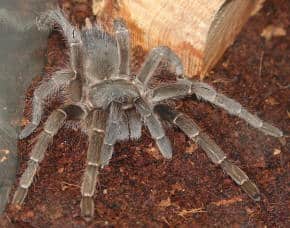
You can keep them at bay by changing out all the substrate and cleaning the cage and any “decorations” with warm soapy water or bleach (but rinse well!) You can also buy predatory mites from a beneficial insectaria to kill the pest mites. After the pest mites are gone, the predatory mites die.
